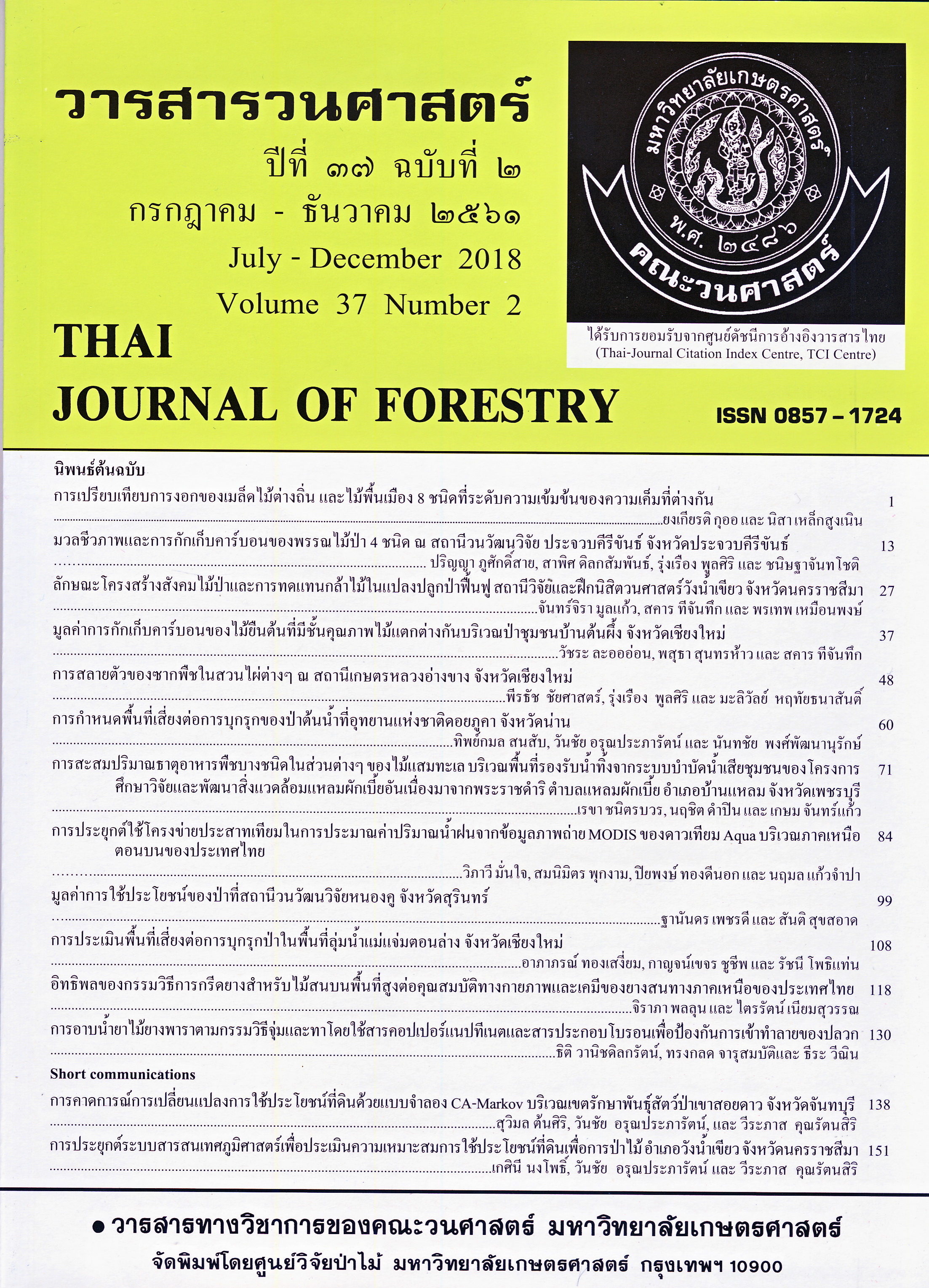ลักษณะโครงสร้างสังคมไม้ป่าและการทดแทนกล้าไม้ในแปลงปลูกป่าฟื้นฟู ณ สถานีวิจัยและฝึกนิสิตวนศาสตร์วังน้ำเขียว จังหวัดนครราชสีมา
Main Article Content
บทคัดย่อ
ผลการศึกษา พบว่า ความหนาแน่นของไม้ใหญ่ ไม้รุ่น และกล้าไม้ ของป่าดิบแล้ง เท่ากับ 1,333, 2,933 และ 2,233 ต้นต่อเฮกตาร์ แปลงปลูกป่าฟื้นฟูอายุ 14 ปี เท่ากับ 1,725, 650 และ 3,933 ต้นต่อเฮกตาร์ แปลงปลูกป่าฟื้นฟูอายุ 12 ปี เท่ากับ 853, 2,833 และ 3,066 ต้นต่อเฮกตาร์ แปลงปลูกป่าฟื้นฟูอายุ 6 ปี เท่ากับ 1,150, 1,883 และ 1,800 ต้นต่อเฮกตาร์ และแปลงปลูกป่าฟื้นฟูอายุ 4 ปี เท่ากับ 300, 2,125 และ 1,000 ต้นต่อเฮกตาร์ ส่วนพื้นที่หน้าตัดของไม้ใหญ่ ป่าดิบแล้งมีค่ามากที่สุด 28.47 ตารางเมตรต่อเฮกตาร์ รองลงมาคือ แปลงปลูกป่าฟื้นฟูอายุ 14 ปี, อายุ 6 ปี, อายุ 12 ปี และอายุ 4 ปี 16.36, 7.00, 3.28 และ 2.68 ตารางเมตรต่อเฮกตาร์ตามลำดับ ซึ่งมีแนวโน้มเช่นเดียวกับมวลชีวภาพเหนือพื้นดิน เท่ากับ 192.32, 91.38, 19.33, 14.52 และ 11.84 ตันต่อเฮกตาร์ ความคล้ายคลึงในระดับไม้ใหญ่และไม้รุ่น พื้นที่แปลงปลูกป่าฟื้นฟูอายุ 14 ปีมีความคล้ายคลึงกับป่าดิบแล้งสูงที่สุด และเมื่อพิจารณาถึงการทดแทนของกล้าไม้พบว่าแปลงปลูกป่าฟื้นฟู ทั้ง 4 แปลงยังมีความคล้ายคลึงกับป่าดิบแล้งน้อย ชนิดกล้าไม้ที่พบส่วนมากจัดเป็น ไม้เบิกนำ (Pioneer species) ซึ่งเป็นชนิดพันธุ์ที่ขึ้นในพื้นที่เพียงชั่วคราวในขั้นตอนของการทดแทนและการปลูกฟื้นฟูในช่วงเริ่มต้น เมื่อพิจารณาจากชนิดพันธุ์ในพื้นที่ที่มีช่วงความทนทานทางนิเวศวิทยาสูง เพื่อให้บรรลุวัตถุประสงค์ของการฟื้นฟู
Downloads
Article Details
ข้าพเจ้าและผู้เขียนร่วม (ถ้ามี) ขอรับรองว่า ต้นฉบับที่เสนอมานี้ยังไม่เคยได้รับการตีพิมพ์และไม่ได้อยู่ในระหว่างกระบวนการพิจารณาตีพิมพ์ลงในวารสารหรือสิ่งตีพิมพ์อื่นใด ข้าพเจ้าและผู้เขียนร่วม (ถ้ามี) ยอมรับหลักเกณฑ์และเงื่อนไขการพิจารณาต้นฉบับ ทั้งยินยอมให้กองบรรณาธิการมีสิทธิ์พิจารณาและตรวจแก้ต้นฉบับได้ตามที่เห็นสมควร พร้อมนี้ขอมอบลิขสิทธิ์ผลงานที่ได้รับการตีพิมพ์ให้แก่วารสารวนศาสตร์ คณะวนศาสตร์ มหาวิทยาลัยเกษตรศาสตร์ กรณีมีการฟ้องร้องเรื่องการละเมิดลิขสิทธิ์เกี่ยวกับภาพ กราฟ ข้อความส่วนใดส่วนหนึ่ง หรือ ข้อคิดเห็นที่ปรากฏในผลงาน ให้เป็นความรับผิดชอบของข้าพเจ้าและผู้เขียนร่วม (ถ้ามี) แต่เพียงฝ่ายเดียว และหากข้าพเจ้าและผู้เขียนร่วม (ถ้ามี) ประสงค์ถอนบทความในระหว่างกระบวนการพิจารณาของทางวารสาร ข้าพเจ้าและผู้เขียนร่วม (ถ้ามี) ยินดีรับผิดชอบค่าใช้จ่ายทั้งหมดที่เกิดขึ้นในกระบวนการพิจารณาบทความนั้น”
เอกสารอ้างอิง
ภาณุพงษ์ คงดำ, สมบัติ พิมพ์ปะสิทธิ์, จงรัก วัชรรินทร์รัตน์ และดอกรัก มารอด. 2559. โครงสร้างและองค์ประกอบพรรณพืชในสวนป่าสักฟื้นฟู ศูนย์ศึกษาธรรมชาติและท่องเที่ยวเชิงนิเวศ เจ็ดคด-โป่งก้อนเส้า อำเภอแก่งคอย จังหวัดสระบุรี. วารสารวนศาสตร์ 35 (1): 11-23.
สุพล คำเสนาะ, จงรัก วัชรินทร์รัตน์ และดอกรัก มารอด. 2556. การทดแทนของสังคมพืชบริเวณป่าปลูก และป่าดิบแล้งทุติยภูมิในพื้นที่ป่าสงวนแห่งชาติป่ามวกเหล็ก-ทับกวาง แปลง 2 จังหวัดสระบุรี. วารสารวนศาสตร์ 32 (3): 12-21.
Elliott, S. 2000. Defining forest restoration for wildlife conservation. pp 13-17. In S. Elliott, J. Kerby, D. Blakesley, K. Hardwick, K. Woods and V. Anussarnsunthorn, eds. Forest Restoretion for Wildlife Conservation. Chiang Mai University.
FRIS. 2003. WCMC Forest Restoration: Forest Restoration Information Service. Concepts and Definitions. Available source: http://www.unep-wcmc.org/forest/restoration/concept.htm, May 28, 2003.
Kutintara, U. 1975. Structure of the Dry Dipterocarp Forest. Ph.D. Thesis, Colorado state University, Fort Collin, Colorado.
Shannon, C.E. and W. Weaver. 1949. The Mathematical Thory of Communication. Univ.lllinois Press, Urbana
Smitinand, T. 1977. Vegetation and Groud Covers of Thailand. The Forest Herharium, Royal Forest Department., Bangkok, Thailand.
Tsutsumi, T., K. Yoda, P. Sahunalu, P. Dhanmanonda, and B Prachaiyo. 1983. Forest : Burning and Regeneration, pp. 13-26. In K. Kyuma and C. Pairitra, eds. Shifting Cultivation, An Experiment at Nam Phrom, Northeast Thailand, and Its Implications for Upland Farming in the Monsoon Tropics. Kyoto university, Japan.


